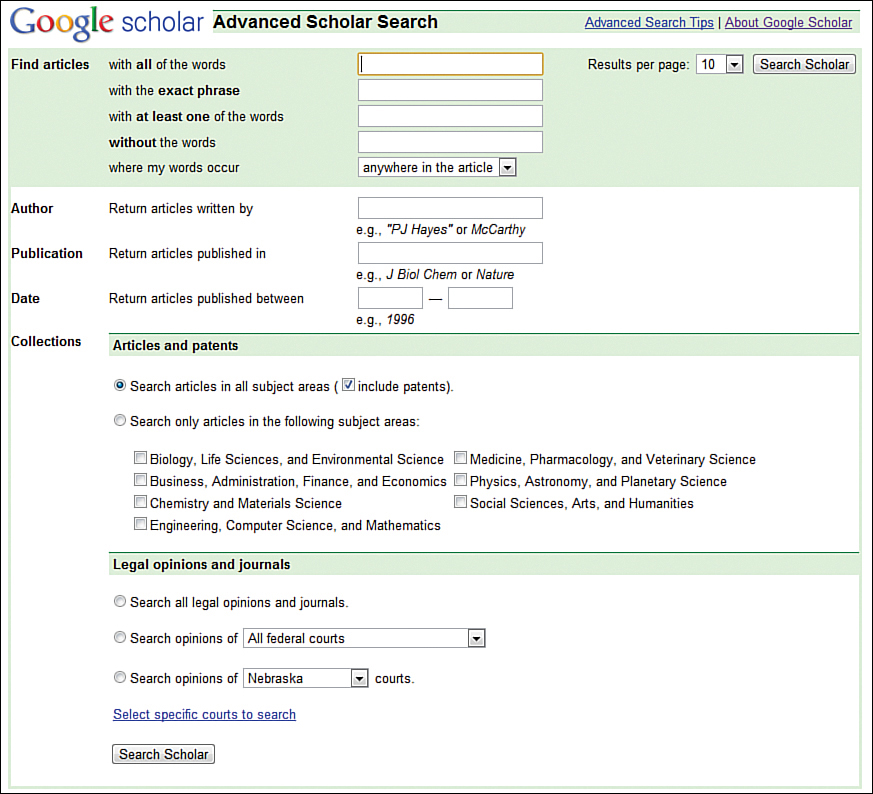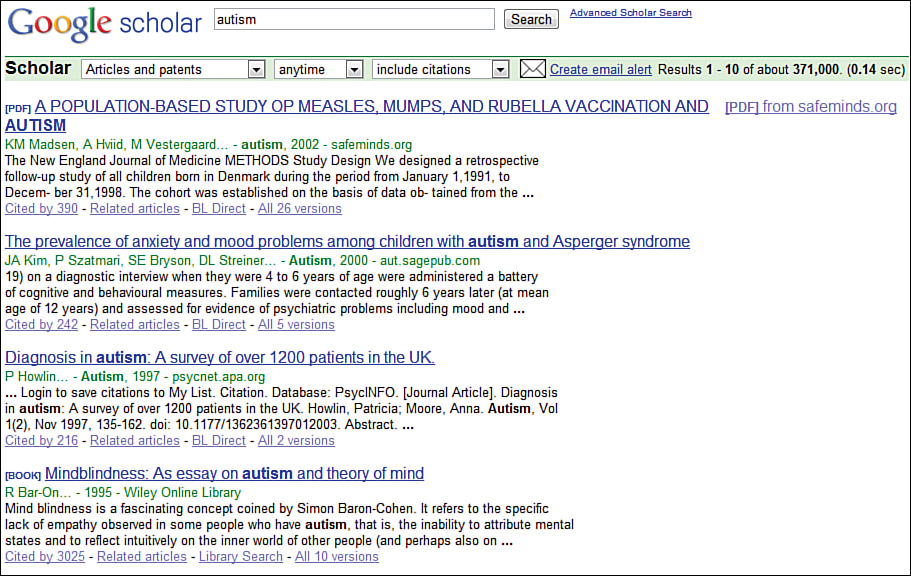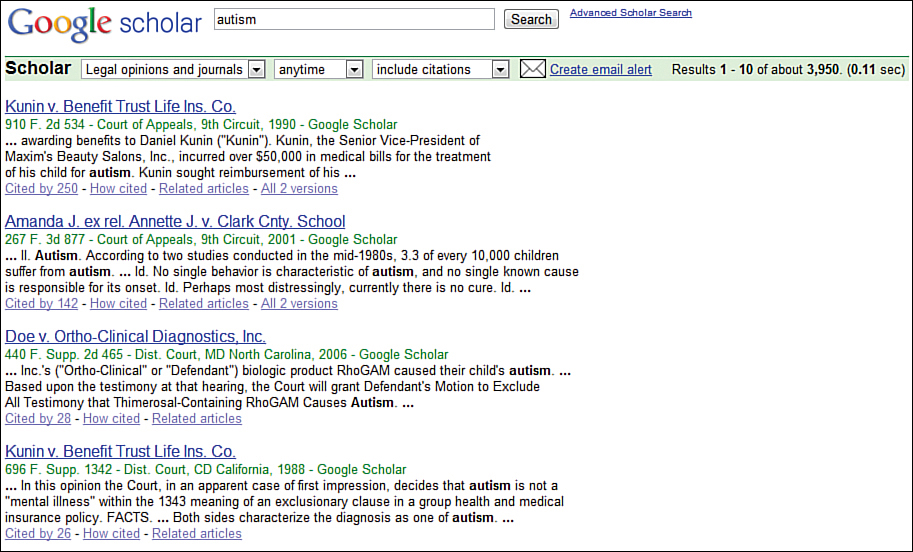Searching for Scholarly Information
As great as Google is for the average Internet user, it can also be a librarian’s worst nightmare. Many students and researchers are abandoning bricks-and-mortar libraries (and proprietary online research services) in favor of Google’s free online searches. Almost any piece of information, it seems, can be found with a standard Google web search.
Or can it?
Google’s web search engine indexes only that part of the Internet that is accessible to the general public. It doesn’t access the tons of information stored in private research databases, or that exists in print journals and reference books found only in university and research libraries. Although you could use Google to conduct research or write a scholarly paper, the amount of true scholarly information available to you would be limited—and difficult to separate from all the home-grown information out there. Google, it seems, is more for the hobbyist than for the serious student or professional researcher.
To their credit, the folks at Google recognized this deficiency and acted on it. The result is called Google Scholar. Google Scholar enables anyone—students, researchers, even the general public—to search a database of scholarly journals and articles free of charge. Now students and researchers can conduct their research from the comfort of their dorm rooms and offices, without having to trudge down to the local library.
How Google Scholar Works
Google Scholar draws raves from its scholarly audience as a viable (and free) alternative to the expensive research databases offered by Elsevier, Thomson, and other scholarly publishers. Although some librarians say that Google Scholar doesn’t offer quite the quality and quantity of results of its more-established rivals, others praise it for its easy access and simple operation.
When you search Google Scholar, you receive a list of matching articles, journals, papers, theses, books, and the like, along with a brief summary of each item. Much of the information displayed on the search results page is available online free of charge. Some is available online only for subscribers to a particular service. Some is available online only for members of a particular library. And some is available in printed format only.
The information in the Google Scholar database is also available via a traditional Google web search; although, it’s often buried deep in the search results. The advantage of Google Scholar is that it focuses your search solely on the scholarly literature and returns results in a format familiar to students and researchers. The search itself is also fine-tuned for the scholarly crowd; you can confine your search to specific disciplines, authors, and publications.
Put another way, Google Scholar is a way for students and researchers to find academically appropriate and peer-reviewed literature without having to wade through all the nonprofessional information that clutters the public Internet.
 TELL ME MORE Media 12.1—Using Google Scholar to Find “Invisible” Information
TELL ME MORE Media 12.1—Using Google Scholar to Find “Invisible” Information
To learn more about how Google Scholar finds scholarly information online, listen to the audio clip titled “Using Google Scholar to Find ‘Invisible’ Information” on the companion Using website at http://www.quepublishing.com.
Identifying Scholarly Content
To identify content for inclusion in the Google Scholar database, Google uses an algorithm that guesses at what it thinks is scholarly content. As with Google’s PageRank algorithm, the Google Scholar algorithm is a closely guarded secret.
What we do know is that the algorithm tries to identify credentialed authors and searches for citations for each article. These citations are extracted and analyzed; at least in part, Google examines the connections between other documents that cite the article in question. This citation analysis is also used to help rank documents within the Google Scholar results. (Google Scholar also takes into consideration the full text of each article, the article’s author, and the publication in which the article appeared to make its rankings.)
Searching Beyond the Public Internet
Google Scholar not only searches the public Web for scholarly information, it also strives to include articles, journals, and books from major scholarly publishers. If the full text of a document is not available for dissemination via the public Web, Google still includes an abstract from the document; you can then choose whether to pay for access. (If that option is available; some materials require a subscription to the host library for access.)
Some of this nonpublic information is available through Google’s partnering with major scholarly research services and libraries. For example, Google Scholar derives some of its content from the Open WorldCat database, which contains records of materials owned by libraries that participate in the Online Computer Library Center (OCLC) project. (You can learn more about OCLC and Open WorldCat at www.oclc.org.)
Including Print-Only Content
For some scholarly literature, the publication itself is not actually online; only the abstract and citations are available over the Internet. This is a benefit of including information sourced from various library databases—you can find out what documents a library has available, even if you can’t download them from the Internet.
Searching Google Scholar
Searching Google Scholar is much like using Google to search the Web—but with some advanced options of value to trained researchers.
Conducting a Basic Search
You conduct most basic searches from the Google Scholar home page, located at scholar.google.com. As you can see in Figure 12.1, this page closely resembles the traditional Google web search page.
Figure 12.1 The Google Scholar main search page.
![]() LET ME TRY IT
LET ME TRY IT
How to Search Google Scholar
Here’s how to conduct a basic Google Scholar search:
1. From the Google Scholar home page, enter your query into the search box.
2. To search for scholarly articles, select the Articles option. Or to search for items from the legal profession, select the Legal Opinions and Journals option.
3. Click the Search button.
 SHOW ME Media 12.2—How to Search Google Scholar
SHOW ME Media 12.2—How to Search Google Scholar
To learn more about conducting basic searches, see the video titled “How to Search Google Scholar” on the companion Using website, http://www.quepublishing.com.
Using Advanced Search Operators
-Scholarly research can be slightly more exacting than typical web searching. More often than not you’re searching for articles by a particular author, or for articles from a specific publication. To fine-tune your search in this manner, you can use most of the same search operators discussed in Chapter 2, “Searching the Web with Google”—in particular, +, –, “ ”, OR, and intitle:.
There’s one new operator specific to Google Scholar. The author: operator enables you to search for articles written by a specific author. To use this operator, enclose the author’s name in quotation marks and place it directly after the operator, like this: author:“m miller”. If you’re interested in finding references to works by that author (as opposed to the author’s works themselves), skip the author: operator, and simply enclose the author’s name in quotation marks as an exact-phrase search.
The exact-phrase operator is also useful when you’re searching for a particular article or publication. Simply enclose the article/publication title in quotation marks, like this: “discovering peer to peer”. No other operator is necessary.
Using the Advanced Scholar Search Page
Even more fine-tuning is available from the Google Scholar Advanced Scholar Search page. You access this page, as shown in Figure 12.2, by clicking the Advanced Scholar Search link on the main Google Scholar page.
Figure 12.2 Using the Advanced Scholar Search page.
As you can see, the top part of this form offers pretty much the same type of fine-tuning available from the normal Google Advanced Search page (or by using advanced search operators). You have the option to search for all the words (default), an exact phrase (“ ”), at least one of the words (OR), and without the words (–). The new option here is the last one, which enables you to specify where in the article to search—in the title only, or anywhere in the article (the default).
The other options on this page include the following:
• Author. Use this option to find articles written by a specific author.
• Publication. Use this option to find articles published in a specific publication.
• Date. Use this option to find articles published within a specified date range.
• Collections. When searching articles and patents, select specific subject areas to search. When searching legal opinions and journals, select to search opinions of specific Federal or state courts.
Viewing Google Scholar Search Results
When you conduct a Google Scholar search, the results returned are limited primarily to scholarly articles, journals, theses, books, and the like. (Articles tend to make up the bulk of Google Search results.)
Viewing Scholarly Results
The information you see about a particular search result depends on what type of document it is. Now work through the possibilities, starting with searches for scholarly articles. Figure 12.3 shows a typical Google Scholar results page for a scholarly search.
Figure 12.3 Results of a typical scholarly search.
If it’s an article available online, the title is clickable. When you click the title, you’re taken either to the full text of the article or (if the article itself is available only via subscription) to the article’s abstract. If the article is available for purchase via the British Library, a BL Direct link displays; click this link for purchase information.
If it’s an article not available online, the title is not clickable, and the word [CITATION] appears beside the title. In this instance, you may find the information you want by displaying the article’s citations.
If it’s a book that’s available in electronic form online, the word [BOOK] appears beside the title, and the title is clickable. When you click the title, you’re taken either to the full text of the book or (if the book is available only via subscription) to the book’s abstract.
If it’s a book that’s not available online, the word [BOOK] appears beside the title, and the title is not clickable. You can also see a Library Search link; click this link to find a library that carries the hardcopy book.
For each article listed on the search results page, you see some or all the following information:
• Title of the book or article. If the full text or abstract is available online, the title is a clickable link.
• Bibliographic information (in green), including author, publisher, and so on.
• Cited By link, which links to a list of other articles and documents that cite this particular article.
• Related Articles link, which lists other articles on the same topic.
• View As HTML link, which lets you view a PDF-format article in normal web page format.
• Library Search link, available when a book is listed, which lets you view a list of real-world libraries that carry copies of the book.
• BL Direct link, available when an article is available for purchase via the British Library.
• All X Articles, link, visible when an article is one of several in a group of scholarly works. Click the link to view a list of the other articles.
 SHOW ME Media 12.3—Viewing Google Scholar Results
SHOW ME Media 12.3—Viewing Google Scholar Results
To learn more about Google Scholar results, see the video titled “Viewing Google Scholar Results” on the companion Using website, http://www.quepublishing.com.
Viewing Legal Results
Legal results are similar to scholarly results. (Figure 12.4 shows results of a typical legal search.)
Figure 12.4 Results of a typical legal search.
For legal rulings, the main link is to the ruling itself. Click the How Cited link to view a list of relevant quotes from citations of the ruling. View all citations by clicking the Cited By link; view articles about the ruling by clicking the Related Articles link.
 SHOW ME Media 12.4—Viewing Legal Results
SHOW ME Media 12.4—Viewing Legal Results
To learn more about Google Scholar’s legal results, see the video titled “Viewing Legal Results” on the companion Using website, http://www.quepublishing.com.
How to Use Google Scholar Results
To best use Google Scholar results, you should first try clicking the article title. If this option isn’t available, or if you’re taken to an abstract only, you can use the Cited By link to search for related articles and information. (You can also try to find the full-text article at your local library, of course.)
If you find a book that looks interesting, and if the book isn’t available for online reading (most aren’t), it’s time to head to the library. Click the Library Search link to find a list of libraries that carry the book, and then put on your jacket and make a visit.
Linking to Information at Your Library
I mentioned previously that some search results might have a FindIt @ link next to the title. This indicates that the article is available for reading from your local or university library.
How does Google Scholar know which library you’re using? If you’re logging on from a campus computer, this information should be sensed automatically. But if you’re logging on from another location, you can manually inform Google Scholar which library you normally use.
This is done from the Google Scholar Preferences page, as shown in Figure 12.5; open this page by clicking the Scholar Preferences link on the main Google Scholar page. Scroll down to the Library Links section, enter the name of your library, and click the Find Library button.
Figure 12.5 Specifying your library on the Google Scholar Preferences page.
You see a list of available libraries. You can select up to three libraries from this list; although, you may be prompted to log on to a particular library site before accessing the associated FindIt @ link. Click the Save Preferences button when you finish.





